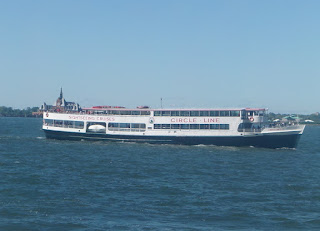I was in Battery Park yesterday morning. It was a
comfortably crisp, bright sunny day. While Hurricane Irma was ravaging the
state of Florida, New York Harbor was the picture of serenity. People have a
knack of compartmentalizing. If it’s not happening to us in real time, it’s a
CNN image, Facebook post, or Yahoo news story. Anyway, as is always the case in
the environs of Wall Street, tourists were omnipresent with their smartphones
working overtime. With imposing backdrops such as the Statue of Liberty, the
Charging Bull, and, of course, the “Freedom Tower,” lower Manhattan is a
photographic haven—a selfie paradise.
In my wanderings, I was thinking about today, the sixteenth
anniversary of 9/11, a dreadful snapshot in time that seems—four Spellman
cycles later—almost inconceivable. How could something like that have happened
where it did and with such unimaginable consequences? Sitting on a tree-shaded
bench on the grounds of Battery Park City, just due west of where the Twin Towers
stood and fell, it was hard to envision what that peaceful setting was like on
9/11/2001. I remember that it was a September day not unlike yesterday—a
winning weather hybrid of identical amounts of summer and fall.
Battery Park City was covered in toxic debris—a couple of
buildings even damaged by airplane parts—after the two towers went down. All of
the structures therein were evacuated and many residents couldn’t return for
lengthy periods of time. A considerable portion of the area was deemed a crime
scene. Approximately fifty percent of the city in a city’s residents
permanently moved from Battery Park City because—for months—the air quality in
the vicinity of Ground Zero was suspect. Ponder this: It was everybody out at a
moment’s notice and no returning home until God knows when. No relocation help
was afforded residents by the powers-that-were, either, and hotel rooms in New
York City were near impossible to come by. And to add insult to injury, some of those who returned after
their extended absences found their apartments ransacked. It took lower rents
and some government subsidies, too, to convince people that Battery Park City
was a nice place to call home. But that was then and this is now.
Ch…ch…ch…ch…changes: Battery Park City is presently where
the elite meet to eat and then some. Built on landfill from the original World
Trade Center’s construction, this development on what were then obsolete, decaying piers on the Hudson River took a while. For a spell there was what
looked like a big sandy beach in the shadows of the Twin Towers. Just do a
Google search on “Battery Park City landfill” or some such thing and see some
amazing pictures of what that part of lower Manhattan looked like not too long
ago in the scheme of things. I wish I had navigated that scene in the
dirty-old-New York 1970s, which most definitely had a perverse charm—one that
gets more charming with each passing day in this increasingly gentrified,
Starbucks universe—but I was too young to explore that far a field. While New
York City was a much more interesting place back then, it also was more dangerous.
In the original planning of Battery Park City, some
low-income housing was included, but fierce opposition squashed that idea. And
I don’t anticipate the soon-to-be reelected Mayor DeBlasio will be locating
homeless families in transitional housing in that prized locale, which is not
having any problem with vacancies nowadays. The bottomless bottom lines
are there to stay and need no further enticements.
(Photographs from the personal collection of Nicholas Nigro)





No comments:
Post a Comment
Note: Only a member of this blog may post a comment.